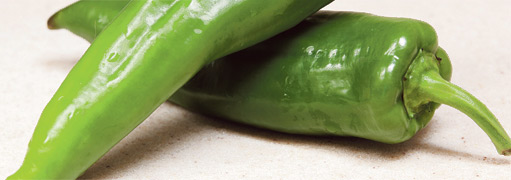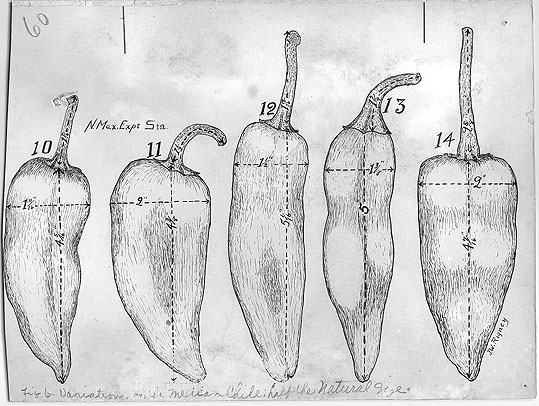I thought I was on the verge of uncovering a conspiracy. It began, as such paranoia often does, on Facebook when a friend of mine posted a perplexing question: Where could he find a good “Hatch enchilada” recipe? When someone responded that Hatch is a town in New Mexico and not a kind of chile, he argued, “But it’s HATCH season. It’s not something else. So I need to use HATCH things in HATCH recipes.”
Did I mention that he’s a Texan? And that we had pretty much this exact conversation last year?
Now, one Texan failing to understand the nuances of green chile isn’t news, but this is not an isolated case of what I’ve come to call Hatch obsession. In fact, I have numerous friends from out of state who are convinced that either New Mexico green chile is called “Hatch” or that there is something special about chile grown in the area around Hatch, N.M. As a person who deeply loves chile from a range of Land of Enchantment regions, I found this odd and somewhat troubling.
Was there, I wondered, some sort of plot on display here? A marketing push by the Hatch Chamber of Commerce to forever associate themselves with green chile both in and out of our state? Or could it be something darker, like an orchestrated effort by the Hatch Chile Company to ruin green chile by linking it to their awful canned version? (Seriously, have you ever had that stuff? It’s the worst.)
I needed to know the cause of this diabolical trend, and I knew there was only one man to ask: The Pope of Peppers himself, Dave DeWitt.
DeWitt is the producer of the National Fiery Foods and Barbecue show, curator of the Fiery-Foods.com website and author of dozens of books about chiles, including The Spicy Food Lover’s Bible, The Chile Pepper Encyclopedia and Dave DeWitt’s Chile Trivia. In other words, when it comes to chile, this guy knows what he’s talking about.
“I’ve been fighting against this for years,” he tells me when I ask about the cult of Hatch. “There’s no special variety of chile known as ‘Hatch,’ nor is there anything special in the soil around Hatch, N.M., that makes their chile extra good.”
According to DeWitt, Hatch chile is, like almost all green chile in the state, a catchall term for a number of varieties of pepper developed and standardized by New Mexico State University. These include Big Jim, Sandia and Joe E. Parker peppers, which should be familiar to anyone who has ever stood in a roasting line.
All these varieties owe their existence to one Dr. Fabian Garcia. He worked in the early part of last century to standardize the disparate kinds of heirloom New Mexican chiles into a form with consistent shape and predictable heat. His hybridized pepper invention, the New Mexico No. 9, was such a success that it grew to dominate the state’s culinary landscape and eventually formed the basis for most of the varieties of chile sold today.
But if Hatch chile is really no different than most New Mexico chile, where does the widespread obsession come from?
“It’s because of the festival,” DeWitt explains, referring to the annual Hatch Chile Festival that began in 1971. It was one of the first of its kind in New Mexico and attracts attendees to Hatch from all over the world to this day. The town’s catchy name stuck in people’s minds when they brought bushels of chile back to their out-of-state homes—thus, a myth was born.
“It’s like an urban legend,” DeWitt says. “In fact, there isn’t enough chile grown in tiny Hatch to meet demand for all the places that supposedly sell Hatch chile.” As a result of the insatiable desire for the product and Hatch’s inability to meet the demand, many of the chiles sold under the Hatch name are grown in other parts of New Mexico, and sometimes in states like Texas and Arizona. This makes the phrase “Hatch chile” even more meaningless.
However, DeWitt points out that there are still a few regions in New Mexico producing distinct chiles that are not descended from Dr. Garcia’s New Mexico No. 9. These heirloom chiles are called landraces, a term referring to plants and animals that have developed primarily through natural selection rather than human-induced breeding, and they’re mostly found in northern New Mexico.
“Chimayó has probably the most famous landrace chile,” DeWitt explains. The Chimayó landrace is well-suited to making a delicious red, he says, “but it can be hard to tell if you’re getting the real deal because so much mislabeling goes on.”
If you’re interested in trying New Mexico chile that truly offers something different from the standardized varieties, DeWitt recommends that you skip Hatch and drive to Chimayó and seek out its landrace. Furthermore, he suggests tasting Chimayó red chile alongside a sauce made from one of the NMSU varieties. “I’d be interested to see what people prefer,” he says.












